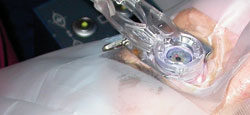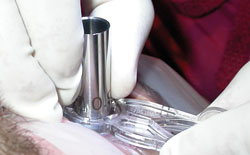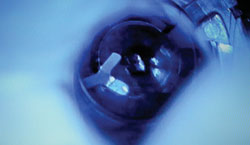Patient interface on femtosecond laser assists placement of intracorneal ring segments
This modification has resulted in improved segment positioning, decreased operating time and increased patient comfort.
 John P. Frangie |
Intacs intracorneal ring segments were initially designed and approved for the treatment of low myopia. In 2001, Colin proposed the use of intracorneal ring segments in the treatment of keratoconus, and U.S. Food and Drug Administration approval for this indication was granted in 2004.
Mechanical placement of Intacs segments (Addition Technology) require the use of a vacuum ring to allow appropriate channel placement. More recently, Rabinowitz et al described a technique utilizing the IntraLase femtosecond laser (Abbott Medical Optics) for the placement of Intacs. This article describes a subtle modification to the initially proposed femtosecond techniques.
Intacs channels are created at a precise depth by the laser; however, these channels are narrow to maximize segment-induced corneal flattening. The purposeful narrowness of these channels often makes the passing of the pigtail-shaped channel dissectors difficult, potentially resulting in a “false pass” and/or aborted procedure. The resistance encountered in passing the channel dissectors results in displacement of the globe, thereby adversely affecting surgeon visualization and resulting in increased treatment time and potentially compromising patient comfort.
 Figure 1. After creation of the Intacs channels with the femtosecond laser, the patient interface remains in place. |
 Figure 2. Fixation of the globe with the patient interface provides counter-traction facilitating passage of the channel dissector. Images: Ryan E |
Femtosecond-assisted technique
The initial case reports of femtosecond-assisted Intacs placement describe creation of the segment channel while the globe is “docked” to the patient interface. The patient interface is subsequently removed from the eye, and Intacs placement proceeds without any further vacuum to assist segment placement. The technique described herein comprises essentially the same steps; however, the patient interface is kept on the globe during the passing of each channel dissector.
This maneuver is analogous to the use of the vacuum ring utilized in the mechanical placement of Intacs segments. An engaged patient interface facilitates the procedure by giving the surgeon some mechanism of counter-traction to the rotational force created by the channel dissection. The patient interface lends itself as a useful adjunct, as its height does not inhibit instrumentation addressing the cornea, and the patient interface finger grips readily permit bimanual manipulation of the fixated globe. After each dissector passes, the patient interface vacuum is broken, and the patient interface is removed from the field. The Intacs segments are then placed and positioned in the conventional manner.
 |
|
|
Figure 3. The patient interface allows the
surgeon to stabilize the eye in the X,Y and Z axes, and provides adequate
visualization and access to the cornea. |
|
We have found that this modification has resulted in improved segment positioning, decreased operating time and a concomitant increase in patient comfort.
References:
- Colin J, Cochener B, Savary G, Malet F, Holmes-Higgin D. Intacs inserts for treating keratoconus: one-year results. Ophthalmology. 2001;108(8):1409-1414.
- Linebarger EJ, Song D, Ruckhofer J, Schanzlin DJ. Intacs: the intrastromal corneal ring. Int Ophthalmol Clin. 2000;40(3):199-208.
- Rabinowitz YS, Li X, Ignacio TS, Maguen E. Intacs inserts using the femtosecond laser compared to the mechanical spreader in the treatment of keratoconus. J Refract Surg. 2006;22(8):764-771.
- John P. Frangie, MD, can be reached at Pioneer Valley Ophthalmic Consultants, 489 Bernardston Road, Suite 101, Greenfield, MA 01301; 413-775-9900; fax: 413-775-9922; e-mail: drfrangie@frangieeye.com. Dr. Frangie has no direct financial interests.

